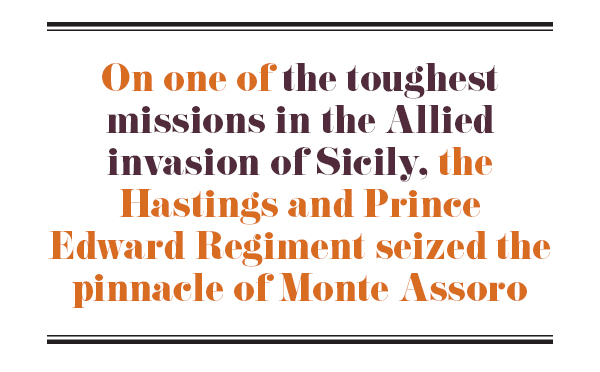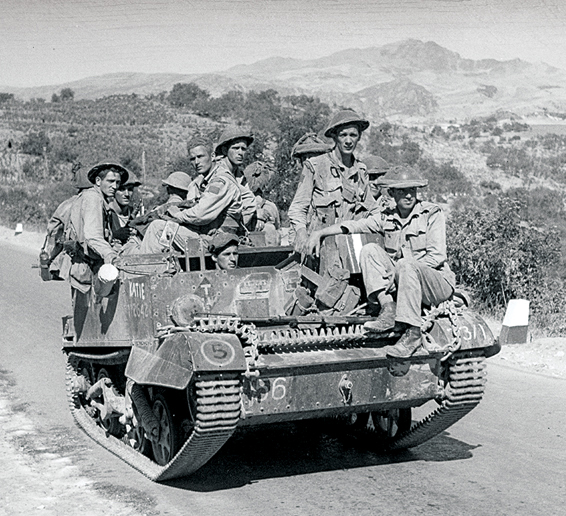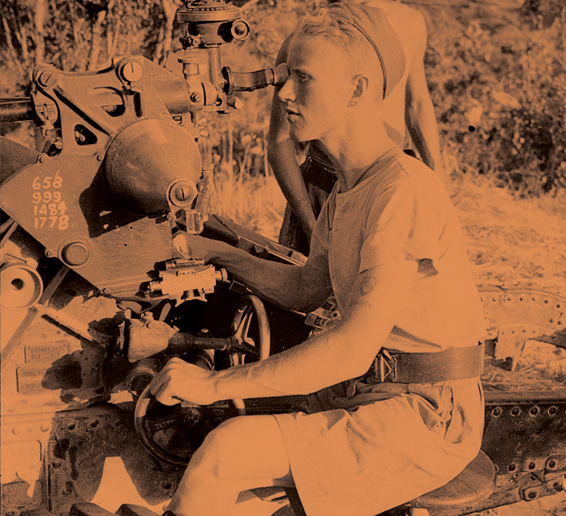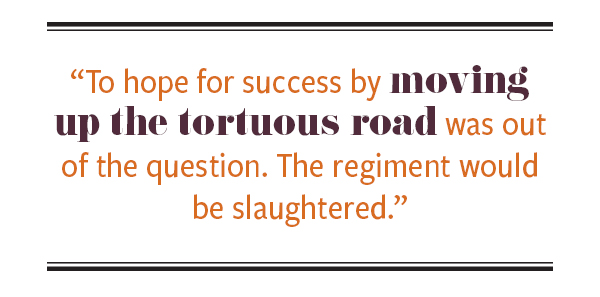
Tanks of the 12th Army Tank Regiment move through the Dittàino River valley south of Monte Assoro in July 1943, depicted in a watercolour by war artist William Ogilvie. [Capt. William A. Ogilvie/CWM/19710261-3634]

Seventy-five years ago, in the early morning darkness of July 10, 1943, more than 2,500 vessels stood off the coast of Sicily, the largest island in the Mediterranean Sea. Aboard were 181,000 American, British and Canadian troops equipped with 14,000 vehicles, 600 tanks and 1,800 artillery pieces. To date, this was the largest amphibious operation in history.
Although Sicily’s coastal defences were badly under strength, the Italians could still inflict heavy casualties if they stood firm. But as the lead regiments came ashore, there was only sporadic firing; most of the Italian troops either fled or surrendered. A few holdouts were killed.
As the advance resumed the next day, the Canadians took thousands of Italian prisoners and resistance rapidly collapsed. But if the Italians were ready to give up, the same was not true for the German divisions dug in inland. They made a stand on every mountain and ridge. For the next 17 days, the Canadians were in constant action, including on July 20, in what would be generally considered the most gallant Canadian operation in Sicily.
Tenacious German resistance to Canadian efforts to break through at the hilltop town of Leonforte to the west made an attack on Assoro essential. Monte Assoro and Leonforte’s summit were tied together by a ridge anchoring the German grip on the two heights. Once Assoro—the enemy’s strongest position—fell, the rest of the German defensive line would become untenable.
The obvious route to Assoro’s summit was a switchback road that carved up the western slope past a village with the same name. Graham knew, however, that the road would be mined and cratered by explosives to prevent tanks from supporting an infantry assault. The houses and adjacent clusters of brush and trees provided countless concealed positions for machine guns and snipers. And the road was exposed to artillery and mortar fire from the summit.
“To hope for success by moving up the tortuous road was out of the question,” Graham told Sutcliffe. “The regiment would be slaughtered.”
Amid the considerable scrub on the almost sheer southeastern mountain face was a series of goat tracks. Standing alongside Graham and Sutcliffe, holding a map, was the Hasty Ps’ intelligence officer, Captain Maurice Herbert Battle Cockin—who had pre-war mountaineering experience in the Andes. The three men agreed that a right hook up the southeast cliff face was the only way. If the goat paths helped, fine, but the Hasty Ps could just scale straight up if needed. Aerial photographs showed the German strength concentrated to cover the road and gentler slopes of the western and northwestern sides while apparently ignoring the steeper east and south sides.
Decision made, Graham headed to 1st Canadian Division’s headquarters to prepare a supporting artillery plan. Sutcliffe and Cockin shifted to the Royal Canadian Regiment’s headquarters to study the cliff more closely. RCR Lt.-Col. Ralph Crowe guided them to a clump of scrubby trees where his anti-tank gun platoon was concealed.
After some discussion, Crowe signalled the platoon’s Lieutenant Sheridan Atkinson over and told him to establish the range by firing a high-explosive tracer-fitted round at the German artillery positions near the summit. When Atkinson passed the order to his gun sergeant, the man adamantly protested that doing so would draw immediate German fire “right up the spout.” Agreeing, Atkinson returned to the senior officers only to have Crowe tell him to do as ordered. Moving one gun from the concealed position, the anti-tank gunners fired the round as Crowe, Sutcliffe and Cockin stood right behind the 6-pounder.

Infantrymen of the Hastings and Prince Edward Regiment advance in a Universal Carrier toward Nissoria, Sicily, north of Monte Assoro, in July 1943. [Lieut. Jack H. Smith/DND/LAC/PA-114511]
Maj. John Buchan, 2nd Baron, assumed the title of Lord Tweedsmuir upon his father’s death in February 1940. The Briton simultaneously took command of a company of Hasty Ps. Soon after, he became the battalion’s second-in-command. Tall, lanky and intense, his regimental nicknames were “Long John” and “Tweedie.”
After Graham hurriedly briefed him on the plan, Tweedsmuir also went to the RCR battalion headquarters to study Monte Assoro. The broad Dittàino valley to the north “ended abruptly in a mass of high hills, showing blue in the early dusk,” he wrote. “A twisting ribbon of white road wound up the slopes in the direction of the town.… Above the town was the highest hill of all. It rose straight and steep from the valley, dominating the hills below.… I realized fully what Cockin had meant by not going down the road.”
Returning to his battalion, Tweedsmuir soon had the men moving by truck to the Dittàino rail station. Here they disembarked and proceeded in single file along a rugged path running to the northeast. “The moon was high now and very bright,” wrote Tweedsmuir. “It shone on rolling pasture land through which dry stream beds cut deep gullies. The path ended and we entered a narrow rocky stream bed…and we stumbled on loose rocks. Every now and then we halted to rest. Once out of the stream bed, the land rose and we found a sheep track.”

To the left, the Hasty Ps could hear the thunder of the Canadian artillery walking shells up the road from Assoro’s base, through the village, and onto the summit. All the division’s field regiments were firing and a British Eighth Army medium regiment also weighed in. Started at 11 p.m., the barrage was to continue until 1 a.m. to mask the sounds of the Hasty Ps approaching and keep the Germans focused on the road.
At the head of the infantry column was a special assault company of hand-picked volunteers led by Capt. Alex Campbell with Lieut. George Baldwin serving as second-in-command and lieutenants Farley Mowat, Fred Burt and Cliff Broad each leading 20-man platoons. Tasked with scaling the cliff and seizing the summit before dawn, these men carried little but their weapons and ammunition.
Tweedsmuir kept close to the column’s front as it wound toward the “loom of the big mountain [that] showed faintly in the blue-black distance.” Soon they reached a gentle slope leading to the cliff and were blocked by a ravine.
It was 4 a.m. and the Hasty Ps had marched 4.5 kilometres. Tweedsmuir felt it would be impossible to traverse the smooth-sided 12-metre-deep ravine, but a rough track was soon found that provided a crossing. As the men crowded against the cliff, the eastern sky was glowing with a false dawn. Campbell’s men were to go straight up with ‘A’ Company following, while Tweedsmuir would take ‘B’ and ‘C’ companies up a longer, gentler path on the eastern slope. ‘D’ Company would remain at the mountain base to protect the rear.
Campbell led his company up the cliff and Tweedsmuir guided the larger force to the right. Both groups were soon engaged in what many later said was the most strenuous and terrifying experience of their war. Mowat said he believed “each of us performed our own private miracle” that night.
Over the centuries, Assoro had been carved into 47 steep and now badly overgrown terraces. The assault company had to scale each terrace by boosting one man to the top who then helped pull another up. Soon a thin line of men stretched along the terrace, pulling up weapons from those below and aiding their ascent. A radio signaller made the climb with a 10-kilogram wireless set strapped on his back—something Mowat thought would normally be impossible even in daylight. Not a man slipped or dropped a weapon or ammunition clip to betray their presence.
“The Germans never thought anybody could cross the rough country approaching Assoro from that direction,” Corporal Bob Wigmore said later. “Of course, they didn’t know Canadians.” Even following the other route, the 32-year-old Tweedsmuir marvelled at the men’s stamina. The march to Assoro’s base had been exhausting. Now, his men seemed to dig deep into some inner core of will and overcome the desire to declare it impossible to continue.
To the left, Mowat closed on what he took for the lip of another terrace and paused, gasping, as another man heaved past, turned on the edge above, and gave a thumbs-up signal. Mowat was surprised to see the man was Private Alfred Keith Long. The 30-year-old was a quiet, often detached loner who Mowat knew could have been an officer but refused even a lance-corporal’s promotion. Long was a man who obeyed orders only if he agreed with them. Yet here he was, the first man to gain the summit.
The Sicilian dawn was coming with subtropical suddenness—promising another searing summer day. Pte. Long disappeared. Then the silence was shattered by the rattle of a Thompson submachine gun. Mowat hauled himself onto the summit. Directly ahead, down on a knee, was Long pointing his gun at three German privates standing next to a tripod-mounted telescope. Dead on the ground was a sergeant wearing an artilleryman’s shoulder straps. “The crazy bastard…went for his gun,” said Long.
Surging past Mowat and Long, the rest of the assault company sprinted to secure the summit. Tweedsmuir’s force arrived minutes later. Peering around a corner of the castle, he was astonished to see not a single German. The summit, with parched dry grass growing under widely interspersed clusters of wild oaks, was deserted.

Gunner J.R. Walsh of the 2nd Field Regiment, Royal Canadian Artillery, operates the sight of a 25-pounder in Sicily. Some 1,800 artillery weapons were used in the Allied invasion of Sicily in July and August 1943. [Lieut. Jack H. Smith/DND/LAC/PA-134528]

There were about 500 Hasty Ps on the summit now. Those not firing were hacking out trenches. “We dug in the best we could,” said Wigmore, but the summit was rocky and digging was hard. The Germans of 15th Panzer Grenadier Division responded rapidly, pouring from the trucks and erupting from the village with machine guns and rifles blazing. Four light anti-aircraft guns alongside the road were cranked down to fire point-blank at the Canadians. Machine-gunners set up behind a stone wall and started duelling with the Bren gunners. German artillery swung nearby guns away from where they had been shelling the Canadians fighting at Leonforte, and soon Assoro’s summit was almost hidden in the dust of exploding volleys. Over the course of three hours, the Hasty Ps were subjected to between 200 and 300 shells.
Whenever the artillery paused, the Grenadiers pressed forward only to be thrown back by bursts of gunfire. The Hasty Ps were burning through the ammunition lugged with them at a fierce rate. Water was also fast disappearing and the summit had no well. As the sun rose higher, baking the hard, Sicilian ground, the Hasty Ps fought with their backs against a wall.
Cut off and knowing immediate relief was unlikely, Tweedsmuir decided to take the fight to the enemy. The German artillery had switched to time-fused shells that showered down shrapnel and wounded 20 men. The casualties were crowded into a small cave. Tweedsmuir knew he had to stop the artillery. That was when somebody remembered the spotter’s telescope.
Running across ground lashed by shrapnel, a soldier retrieved the scope and handed it to Maj. Bert Kennedy, who had pre-war artillery training. Summoning the signaller who had climbed with the assault company, Kennedy cut into the Canadian artillery net and within minutes was directing shells onto the German guns. With the scope’s 20-power precision optics, not a German gun position escaped detection. By noon, about half the German guns were knocked out and the rest were being withdrawn beyond effective range.
For several hours, the Hasty Ps’ long siege of July 21 ground on with the Germans offering only desultory harassing fire. But the men on the summit were exhausted, some nodding off even when under fire.
At 8 p.m., German heavy mortars started firing and two Panzer Grenadier companies raced from the village toward the summit. Ammunition desperately short, the Hasty Ps tried to make every shot count. Kennedy, meanwhile, called for an immediate bombardment of the village.
“As the shells shrieked into the tightly packed houses,” wrote Tweedsmuir, “it occurred to me to wonder whether this was the origin of the phrase ‘to paint the town red.’ Our guns pounded the town intermittently and a long night began.” Below the summit, German dead littered the ground. In the early morning hours of July 22, a Royal Canadian Regiment. relief column comprised of ‘D’ Company commanded by Capt. Charles Lithgow followed the route taken by Tweedsmuir’s column. With supplies stuffed into “their small packs, which they had emptied of all their personal possessions, in some Everest packs and in bandoliers around their necks,” the men brought the Hasty Ps a full day’s ration and ammunition resupply. The company made the round trip without suffering a single casualty.
On the summit, Tweedsmuir was elated: “We were now well fed and well enough armed to deal with anything.”
Meanwhile, at dawn on July 22, two companies of 48th Highlanders of Canada had advanced along a steep cross-country route toward the village while a tank troop of the Three Rivers Regiment—aided by engineers filling craters and lifting mines—started grinding up the road. Soon Lieut. Slim Waldron’s tanks reached a position providing a line of fire into the village situated right “amid a ghastly mess of burned and shot-up vehicles, with burned bodies strewn about them and breathing the unforgettable stench of burned human flesh.”
As artillery pounded the town and tankers fired their 75-millimetre guns into its heart, the Highlanders broke into the village at 11 a.m. The Germans offered only sufficient fight to cover their withdrawal. By 2 p.m., the Hasty Ps on the summit were relieved.
During their heroic stand, only eight men were killed—the number of wounded never recorded. The 48th Highlanders had two dead and 16 wounded. Canadian Press correspondent Ross Munro arrived in time to “see Germans running through the grove for shelter in a valley behind. The Hastings grinned. They had…stuck it out.”
Munro later reflected that of “all the actions in Sicily, I look back on this exploit of the Hastings at Assoro as the most daring and spectacular.”
Advertisement






















